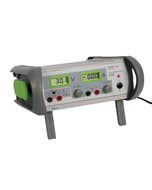Peltier module heat pump
Demonstration model with two aluminum water containers thermally connected to the surfaces of a Peltier element.
When an electric current passes through the Peltier element, a heat exchange between the containers cools one side and heats the other.
In both water containers, an electric stirrer ensures a uniform temperature distribution. Two digital thermometers display the two water temperatures. Knowing the system's thermal capacity allows us to determine the refrigeration power and thermal power and compare them to the supplied electrical power.
The system is provided in a convenient portable case that also ensures effective thermal insulation with the environment.
Possible experiments:
- Peltier heat pump in symmetrical and asymmetrical mode
- Recording temperature curves during the pumping and slowing phase
- Heating, cooling, and electrical power, power index, efficiency degree
- Seebeck coefficient
- Peltier effect, Joule losses, heat return based on thermal conduction by the Peltier element
- Thermal transfer and conductivity coefficients
- Ratio between thermal and supply voltage and different temperature
|
Caractéristiques techniques
Peltier Module:
Supply voltage: 5 ... 8 V Power consumption at 8 V: 2.5 ... 3.5 A Surface: 40 x 40 mm² Thickness: 3.7 mm Seebeck coefficient S: approx. 0.04 V/K Electrical resistance R: approx. 2.4 Ω Thermal conductance κ: approx. 0.2 W/K Water tanks: Weight of an empty tank: 105 g Specific heat capacity of an empty tank: 0.094 J/K Water filling level: 200 ml Thermal capacity of the water in the tank: 0.836 J/K Heat capacity of a full tank: 0.930 J/K Heat transfer coefficient α: 0.7 ... 0.8 W/K Overall dimensions: 244 x 160 x 70 mm³ Total weight: 920 g |






